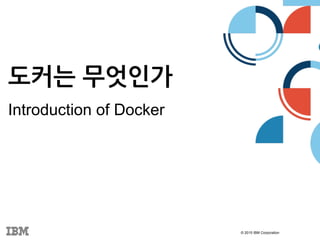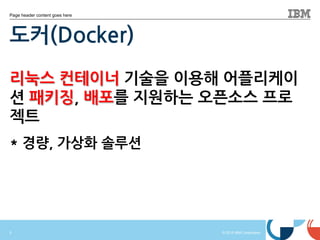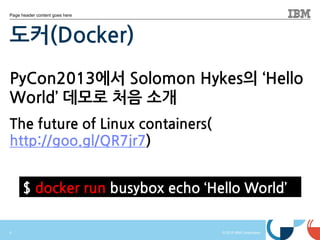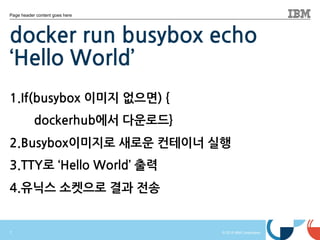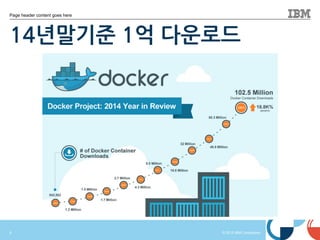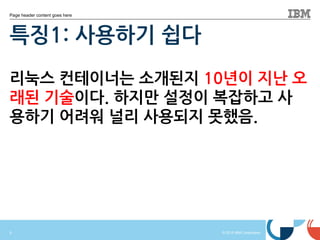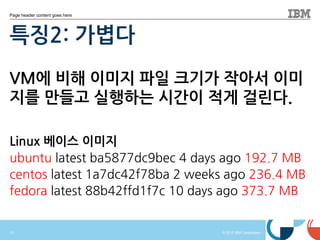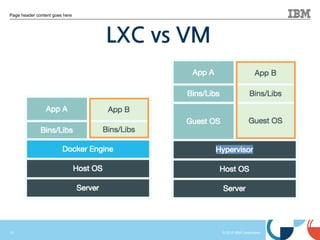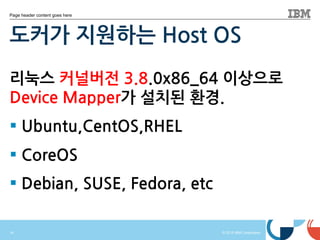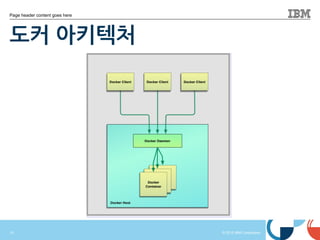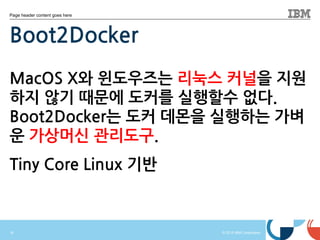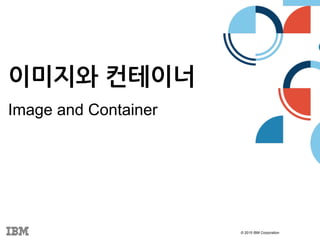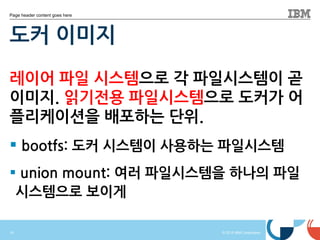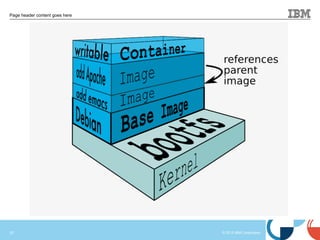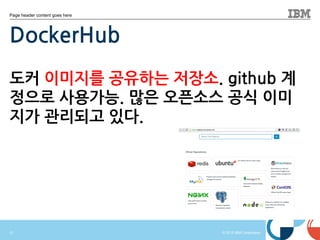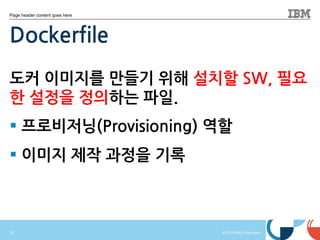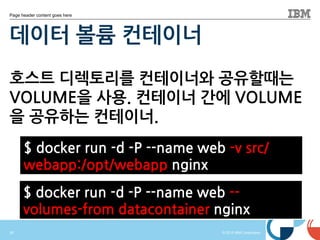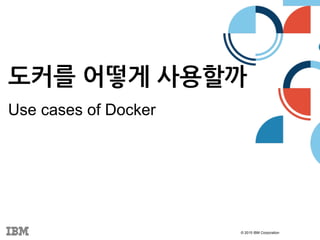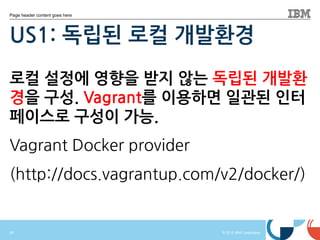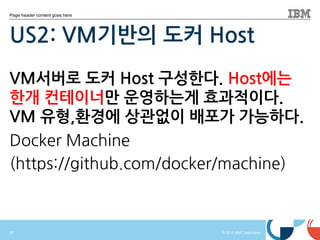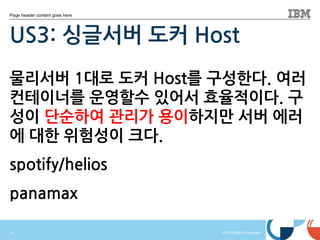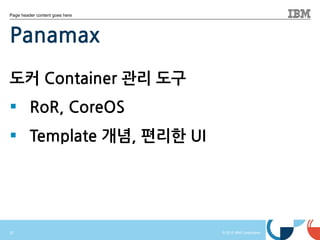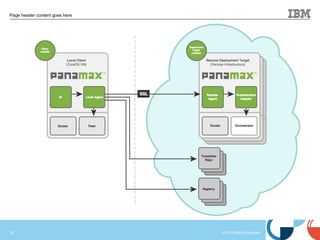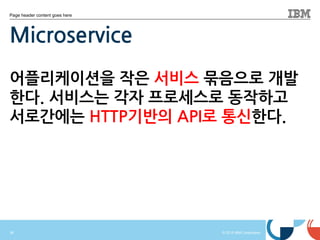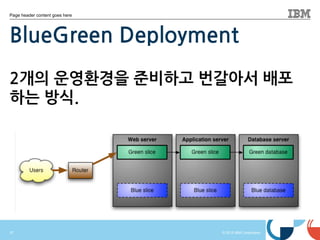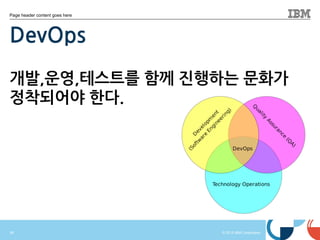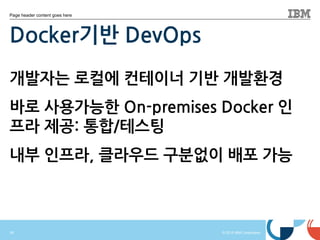DevOps with Docker
- 1. ? 2015 IBM Corporation ???? ???? ??ėHėH DAY! ???? ???? ??, 50? MM/DD/YY DevOps
- 2. ?with
- 3. ?Docker
- 4. ? ???/SK
- 5. ?planet
- 6. ?
- 7. ? 2015 IBM Corporation2 Page header content goes here ??
- 8. ???
- 9. ? ???
- 10. ?
- 11. ? Platform
- 12. ?Architecture
- 13. ?Team
- 14. ?/SK
- 15. ?planet
- 16. ? ??2015:
- 17. ?Docker
- 18. ???
- 19. ????
- 20. ????
- 21. ? ??2013~14:
- 22. ???/??
- 23. ????
- 24. ???/??
- 25. ?
- 26. ? 2015 IBM Corporation3 Page header content goes here Agenda
- 27. ? Īņ??
- 28. ????
- 29. ?????
- 30. ? Īņ??
- 31. ?????
- 32. ?????
- 33. ? Īņ??
- 34. ????
- 35. ????
- 36. ?????
- 37. ? Īņ??
- 38. ???
- 39. ????
- 40. ????
- 41. ???
- 42. ?
- 43. ?
- 44. ? 2015 IBM Corporation ???
- 45. ?????
- 47. ? 2015 IBM Corporation5 Page header content goes here ??(Docker)
- 48. ? ???
- 49. ?????
- 50. ????
- 51. ????
- 52. ?????? ?
- 53. ????,
- 54. ????
- 55. ?????
- 56. ?????
- 57. ??? ??
- 58. ? *
- 59. ???,
- 60. ????
- 61. ????
- 62. ?
- 63. ? 2015 IBM Corporation6 Page header content goes here ??(Docker)
- 64. ? PyCon2013??
- 65. ?Solomon
- 66. ?Hykes?
- 67. ?Ī«▒ß▒▒¶▒¶┤Ū
- 68. ? WorldĪ»
- 69. ????
- 70. ???
- 71. ???
- 72. ? The
- 73. ?future
- 74. ?of
- 75. ?Linux
- 77. ?
- 78. ? $
- 79. ?docker
- 80. ?run
- 81. ?busybox
- 82. ?echo
- 83. ?Ī«▒ß▒▒¶▒¶┤Ū
- 84. ?░┬┤Ū░∙▒¶╗ÕĪ»
- 85. ?
- 86. ? 2015 IBM Corporation7 Page header content goes here docker
- 87. ?run
- 88. ?busybox
- 89. ?echo
- 90. ? Ī«Hello
- 91. ?░┬┤Ū░∙▒¶╗ÕĪ»
- 92. ?
- 93. ?
- 94. ? 1.If(busybox
- 95. ????
- 96. ????)
- 97. ?{
- 98. ?
- 99. ?
- 100. ?
- 101. ?
- 102. ?
- 103. ?
- 104. ?
- 105. ?dockerhub??
- 106. ?????}
- 107. ? 2.Busybox????
- 108. ????
- 109. ?????
- 110. ???
- 111. ? 3.TTY?
- 112. ?Ī«▒ß▒▒¶▒¶┤Ū
- 113. ?░┬┤Ū░∙▒¶╗ÕĪ»
- 114. ???
- 115. ? 4.???
- 116. ?????
- 117. ???
- 118. ???
- 119. ?
- 120. ? 2015 IBM Corporation8 Page header content goes here 14????
- 121. ?1?
- 122. ?????
- 123. ?
- 124. ? 2015 IBM Corporation9 Page header content goes here ??1:
- 125. ?????
- 126. ???
- 127. ? ???
- 128. ??????
- 129. ?????
- 130. ?10??
- 131. ???
- 132. ?? ??
- 133. ?????.
- 134. ????
- 135. ????
- 136. ?????
- 137. ?? ???
- 138. ????
- 139. ???
- 140. ?????
- 141. ????.
- 142. ?
- 143. ? 2015 IBM Corporation10 Page header content goes here ??2:
- 144. ????
- 145. ? VM?
- 146. ???
- 147. ????
- 148. ???
- 149. ????
- 150. ????
- 151. ??? ??
- 152. ????
- 153. ?????
- 154. ????
- 155. ???
- 156. ????.
- 157. ?
- 158. ? Linux
- 159. ????
- 160. ????
- 161. ? ubuntu
- 162. ?latest
- 163. ?ba5877dc9bec
- 164. ?4
- 165. ?days
- 166. ?ago
- 167. ?192.7
- 168. ?MB
- 169. ? centos
- 170. ?latest
- 171. ?1a7dc42f78ba
- 172. ?2
- 173. ?weeks
- 174. ?ago
- 175. ?236.4
- 176. ?MB
- 177. ? fedora
- 178. ?latest
- 179. ?88b42ffd1f7c
- 180. ?10
- 181. ?days
- 182. ?ago
- 183. ?373.7
- 184. ?MB
- 185. ?
- 186. ? 2015 IBM Corporation11 Page header content goes here ???
- 187. ?????
- 188. ????
- 189. ???
- 190. ? *
- 191. ?????
- 192. ????
- 193. ????
- 194. ????
- 195. ?4MB
- 196. ??? ?
- 197. ???????.
- 198. ? *
- 199. ?16MB
- 200. ?PostgreSQL
- 202. ? *
- 203. ?Raspberry
- 204. ?PI?
- 205. ???
- 206. ? (Raspbian
- 207. ?Wheezy,Docker
- 208. ?1.4.1)
- 209. ?
- 210. ?
- 211. ? 2015 IBM Corporation12 Page header content goes here ???
- 212. ?????(LXC)
- 213. ? ??
- 214. ????
- 215. ?????
- 216. ????(isolated)
- 217. ??? ?
- 218. ?????
- 219. ????
- 220. ?????
- 221. ?OS
- 222. ????
- 223. ?? ??
- 224. ?
- 225. ? Īņ??
- 226. ?OpenVZ(openvz.org)
- 227. ? Īņ??
- 229. ? Īņ??
- 231. ?
- 232. ? 2015 IBM Corporation13 Page header content goes here LXC
- 233. ?vs
- 234. ?VM
- 235. ?
- 236. ? 2015 IBM Corporation14 Page header content goes here ???
- 237. ?????
- 238. ?Host
- 239. ?OS
- 240. ? ???
- 241. ?????
- 242. ?3.8.0x86_64
- 243. ?????
- 244. ? Device
- 245. ?Mapper?
- 246. ????
- 247. ???.
- 248. ? Īņ??
- 249. ?Ubuntu,CentOS,RHEL
- 250. ? Īņ??
- 251. ?CoreOS
- 252. ? Īņ??
- 253. ?Debian,
- 254. ?SUSE,
- 255. ?Fedora,
- 256. ?etc
- 257. ?
- 258. ? 2015 IBM Corporation15 Page header content goes here ??
- 259. ?????
- 260. ?
- 261. ? 2015 IBM Corporation16 Page header content goes here Boot2Docker
- 262. ? MacOS
- 263. ?X?
- 264. ??????
- 265. ????
- 266. ????
- 267. ??? ??
- 268. ???
- 269. ????
- 270. ????
- 271. ?????
- 272. ???.
- 273. ? Boot2Docker?
- 274. ???
- 275. ????
- 276. ?????
- 277. ??? ?
- 278. ?????
- 279. ?????.
- 280. ? Tiny
- 281. ?Core
- 282. ?Linux
- 283. ???
- 284. ?
- 285. ? 2015 IBM Corporation17 Page header content goes here
- 286. ? 2015 IBM Corporation ????
- 287. ?????
- 289. ? 2015 IBM Corporation19 Page header content goes here ??
- 290. ????
- 291. ? ???
- 292. ???
- 293. ??????
- 294. ??
- 295. ???????
- 296. ??
- 297. ? ???.
- 298. ?????
- 299. ????????
- 300. ????
- 301. ?? ??????
- 302. ?????
- 303. ???.
- 304. ? Īņ??
- 305. ?bootfs:
- 306. ???
- 307. ?????
- 308. ?????
- 309. ??????
- 310. ? Īņ??
- 311. ?union
- 312. ?mount:
- 313. ???
- 314. ???????
- 315. ????
- 316. ???
- 317. ? ?????
- 318. ????
- 319. ?
- 320. ?
- 321. ? 2015 IBM Corporation20 Page header content goes here
- 322. ? 2015 IBM Corporation21 Page header content goes here DockerHub
- 323. ? ??
- 324. ?????
- 325. ?????
- 326. ????.
- 327. ?github
- 328. ?? ???
- 329. ?????.
- 330. ???
- 331. ?????
- 332. ???
- 333. ??? ??
- 334. ?????
- 335. ???.
- 336. ?
- 337. ? 2015 IBM Corporation22 Page header content goes here Dockerfile
- 338. ? ??
- 339. ?????
- 340. ????
- 341. ???
- 342. ????
- 343. ?SW,
- 344. ??? ?
- 345. ????
- 346. ?????
- 347. ???.
- 348. ? Īņ??
- 349. ??????(Provisioning)
- 350. ???
- 351. ? Īņ??
- 352. ????
- 353. ???
- 354. ????
- 355. ???
- 356. ?
- 357. ?
- 358. ? 2015 IBM Corporation23 Page header content goes here nginx?
- 359. ???
- 360. ?Dockerfile
- 361. ? #
- 362. ?Version:
- 363. ?0.0.1
- 364. ? FROM
- 365. ?ubuntu:14.04
- 366. ? MAINTAINER
- 367. ?Sangcheol
- 368. ?Hwang
- 369. ?k16wire@gmail.com
- 370. ?
- 371. ? RUN
- 372. ?apt-get
- 373. ?update
- 374. ? RUN
- 375. ?apt-get
- 376. ?install
- 377. ?-y
- 378. ?nginx
- 379. ? RUN
- 380. ?echo
- 381. ?'Hi,
- 382. ?I
- 383. ?am
- 384. ?in
- 385. ?your
- 386. ?container'
- 387. ?
- 388. ? EXPOSE
- 389. ?80
- 390. ?
- 391. ? 2015 IBM Corporation24 Page header content goes here Dockerfile
- 392. ????
- 393. ? FROM:
- 394. ????
- 395. ????
- 396. ???
- 397. ? ENV:
- 398. ?????
- 399. ???
- 400. ? RUN:
- 401. ??????
- 402. ????
- 403. ???
- 404. ???
- 405. ? CMD:
- 406. ?????
- 407. ?????
- 408. ?????
- 409. ????
- 411. ?
- 412. ? 2015 IBM Corporation25 Page header content goes here ??
- 413. ?????
- 414. ? ??/???
- 415. ????
- 416. ???
- 417. ??????
- 418. ???? ?
- 419. ?????.
- 420. ?
- 421. ?
- 422. ? DB,Web,WAS,?
- 423. ?VM??
- 424. ?????
- 425. ????
- 426. ? SW
- 427. ?????.
- 428. ?
- 429. ? 2015 IBM Corporation26 Page header content goes here ???
- 430. ???
- 431. ?????
- 432. ? ???
- 433. ??????
- 434. ??????
- 435. ??????
- 436. ? VOLUME?
- 437. ???.
- 438. ?????
- 439. ???
- 440. ?VOLUME ?
- 441. ?????
- 442. ?????.
- 443. ? $
- 444. ?docker
- 445. ?run
- 446. ?-d
- 447. ?-P
- 448. ?--name
- 449. ?web
- 450. ?-v
- 452. ?nginx
- 453. ? $
- 454. ?docker
- 455. ?run
- 456. ?-d
- 457. ?-P
- 458. ?--name
- 459. ?web
- 460. ?-- volumes-from
- 461. ?datacontainer
- 462. ?nginx
- 463. ?
- 464. ? 2015 IBM Corporation ???
- 465. ????
- 466. ?????
- 467. ? Use cases of Docker
- 468. ? 2015 IBM Corporation28 Page header content goes here US1:
- 469. ????
- 470. ???
- 471. ?????
- 472. ? ??
- 473. ????
- 474. ????
- 475. ???
- 476. ???
- 477. ????
- 478. ???? ??
- 479. ???.
- 480. ?Vagrant?
- 481. ?????
- 482. ????
- 483. ??? ????
- 484. ????
- 485. ???.
- 486. ? Vagrant
- 487. ?Docker
- 488. ?provider
- 490. ?
- 491. ? 2015 IBM Corporation29 Page header content goes here ???
- 492. ???
- 493. ????
- 494. ? ???
- 495. ????
- 496. ?????
- 497. ?boot2docker?
- 498. ?? ???
- 499. ???
- 500. ?????
- 501. ????.
- 502. ?Vagrant?
- 503. ?? ?
- 504. ????VM?
- 505. ????
- 506. ???
- 507. ?docker?
- 508. ??? ??
- 509. ?????.
- 510. ?
- 511. ? 2015 IBM Corporation30 Page header content goes here US2:
- 512. ?VM???
- 513. ???
- 514. ?Host
- 515. ? VM???
- 516. ???
- 517. ?Host
- 518. ?????.
- 519. ?Host??
- 520. ? ??
- 521. ??????
- 522. ??????
- 523. ??????.
- 524. ? VM
- 525. ???,???
- 526. ?????
- 527. ????
- 528. ?????.
- 529. ? Docker
- 530. ?Machine
- 532. ?
- 533. ? 2015 IBM Corporation31 Page header content goes here US3:
- 534. ?????
- 535. ???
- 536. ?Host
- 537. ? ????
- 538. ?1??
- 539. ???
- 540. ?Host?
- 541. ?????.
- 542. ???
- 543. ? ?????
- 544. ?????
- 545. ????
- 546. ??????.
- 547. ?? ??
- 548. ?????
- 549. ????
- 550. ??????
- 551. ???
- 552. ??? ?
- 553. ???
- 554. ?????
- 555. ???.
- 556. ?
- 557. ? spotify/helios
- 558. ? panamax
- 559. ?
- 560. ?
- 561. ? 2015 IBM Corporation32 Page header content goes here Panamax
- 562. ? ??
- 563. ?Container
- 564. ???
- 565. ???
- 566. ? Īņ?? RoR,
- 567. ?CoreOS
- 568. ? Īņ?? Template
- 569. ???,
- 570. ????
- 571. ?UI
- 572. ?
- 573. ? 2015 IBM Corporation33 Page header content goes here
- 574. ? 2015 IBM Corporation34 Page header content goes here US4:
- 575. ???
- 576. ?Host
- 577. ?????
- 578. ? ??
- 579. ???
- 580. ?Host
- 581. ????
- 582. ????
- 583. ?Host??
- 584. ?? ???
- 585. ???
- 586. ?
- 587. ??????
- 588. ?????.
- 589. ???? ?
- 590. ?????,
- 591. ?Host
- 592. ?????
- 593. ???
- 594. ???.
- 595. ? Īņ??
- 596. ?fleet
- 597. ? Īņ??
- 598. ?swarm
- 599. ? Īņ??
- 600. ?kubernets
- 601. ? Īņ??
- 602. ?mesos
- 603. ?
- 604. ? 2015 IBM Corporation ?????
- 605. ????
- 606. ???
- 607. ? DevOps with Docker
- 608. ? 2015 IBM Corporation36 Page header content goes here Microservice
- 609. ? ???????
- 610. ???
- 611. ????
- 612. ?????
- 613. ??? ??.
- 614. ?????
- 615. ???
- 616. ??????
- 617. ?????
- 618. ? ?????
- 619. ?HTTP???
- 620. ?API?
- 621. ?????.
- 622. ?
- 623. ? 2015 IBM Corporation37 Page header content goes here BlueGreen
- 624. ?Deployment
- 625. ? 2??
- 626. ??????
- 627. ?????
- 628. ?????
- 629. ??? ??
- 630. ???.
- 631. ?
- 632. ? 2015 IBM Corporation38 Page header content goes here DevOps
- 633. ? ??,??,????
- 634. ???
- 635. ?????
- 636. ????
- 637. ? ?????
- 638. ???.
- 639. ?
- 640. ? 2015 IBM Corporation39 Page header content goes here Docker??
- 641. ?DevOps
- 642. ? ????
- 643. ????
- 644. ?????
- 645. ???
- 646. ?????
- 647. ? ??
- 648. ??????
- 649. ?On-premises
- 650. ?Docker
- 651. ?? ??
- 652. ???:
- 653. ???/???
- 654. ? ??
- 655. ????,
- 656. ?????
- 657. ?????
- 658. ???
- 659. ???
- 660. ?




